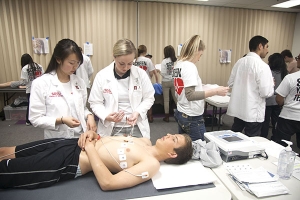
Does your technology-fixated child ever complain of dry, irritated eyes? What about blurry vision, headaches, light sensitivity, neck and shoulder pain, or fatigue? You might look to his electronic devices as potential culprits for these increasingly common, eye-related ailments.
Computer Vision Syndrome (CVS), or digital eyestrain, describes a group of eye and vision-related problems that result from prolonged computer, tablet, e-reader and cell phone use. Typically, individuals who spend two hours or more in front of digital screens are most susceptible.
According to the Vision Council, 90 percent of adults in the United States—and 65 percent of children and teens—fall into this category. Read on to discover what can be done to protect our kids (and ourselves) from the discomforts of digital eyestrain.
Schedule an eye exam.
Uncorrected vision issues are major contributors to CVS. These can be diagnosed through a complete, professional eye examination. An exam should include a discussion of any applicable symptoms and details about your child’s digital device usage. An optometrist or ophthalmologist will take measurements to determine how much vision is affected, how the eyes focus and whether lens correction would be beneficial.
“Our eyes were designed to be flexible and look from far away to up close, back and forth all day long,” explains Aaron Werner, O.D., of Werner Optometry in El Cajon. “However, when we use digital devices we maintain our focus at a close distance for a long period of time, even hours, without allowing our focus to shift. This prolonged focus effort, combined with the glare and short-wavelength light from digital screens, causes problems.”
Reduce screen time.
Kids these days rely on digital devices for everything from relaxation and social interaction to completing essential schoolwork; but the connection between screen time usage and CVS symptoms is clear.
“The level of discomfort appears to increase with the amount of digital screen use,” says Jennifer Tam, O.D., of Sharp Rees-Stealy Medical Group. “I am seeing a rise in kids coming in complaining of blurred vision or headaches after playing video games or being on their tablets watching movies.” Tam suggests that families follow recommended screen time usage guidelines to help prevent these problems.
Recently updated guidelines from the American Academy of Pediatrics (AAP) recommend no screen time at all for kids under 18 months (except video chatting); parent/child co-viewing only for 18-24 months; no more than one hour per day for kids ages 2-5 years; and to set limits for kids 6 years and up.
To set appropriate limits for older kids and teens, the development of a family media plan can help balance the realities of the modern digital world with factors such as school and homework, exercise, sleep and family values. For help creating your family’s personalized plan, visit www.healthychildren.org/English/media.
Take frequent breaks (and blinks).
Both Werner and Tam suggest taking regular screen breaks by following the 20-20-20-rule. This means take a 20-second break, every 20 minutes, to view something 20 feet away.
It seems simple enough, but Werner observes, “Most children and adults look at a screen for nearly 60 minutes before giving their eyes a break.”
Also, don’t forget to blink. “To minimize the chances of developing dry eye when using a computer or digital device, make an effort to blink frequently. Blinking keeps the front surface of the eye moist,” Werner explains.
Establish proper positioning and lighting.
The American Optometric Association (AOA) recommends that computer screens be 4 to 5 inches below eye level, 20 to 28 inches away from the eyes. Tam suggests kids center other digital devices and position 4 to 5 inches below eye level, 18 to 26 inches away.
“An LCD screen is much easier on the eyes and typically has an anti-reflective surface to help reduce glare issues. Also choose a high-resolution screen to obtain sharper images,” Tam says. “Brightness should be adjusted so that it is the same illumination as your surroundings. If possible, reduce your color temperature. Blue light is a short-wavelength visible light that is more associated with visual strain than longer wavelengths, such as orange or red.”
Increase font size as necessary, position the screen to avoid glare from overhead lights and windows and use lower-wattage bulbs and/or adjustable dimmer switches.
Consider task-specific glasses.
“Just like your child would not wear their soccer uniform and cleats to dance class, your eyes may need specific glasses to help when working for longer periods on digital devices,” Werner says. “Having ‘computer glasses’ that focus at this distance give your eyes a break from doing the work.” Specialty lenses can also block a screen’s short wavelength light and glare.
By implementing proper eye care strategies now; the whole family will soon see a clear, comfortable future.
Lisa Pawlak is an award-winning contributing writer and Encinitas resident.



















